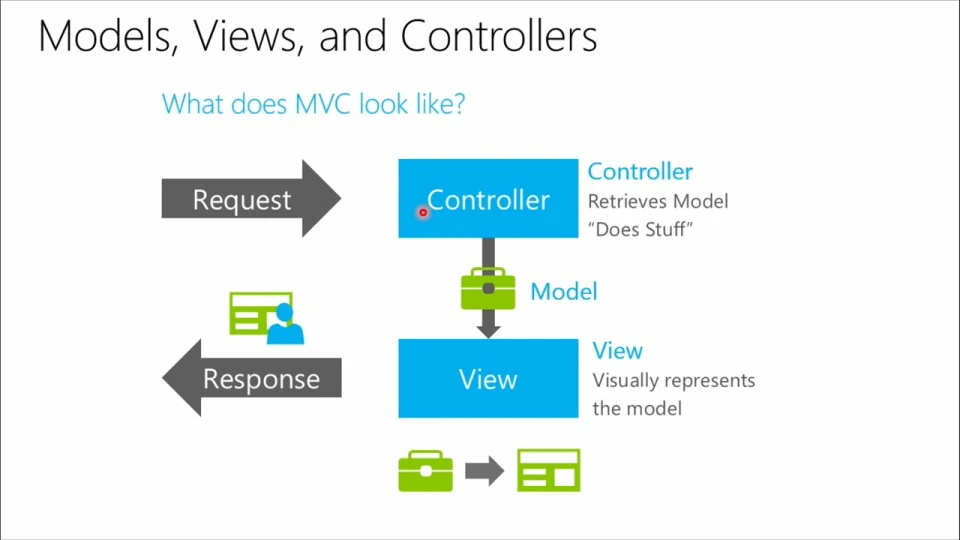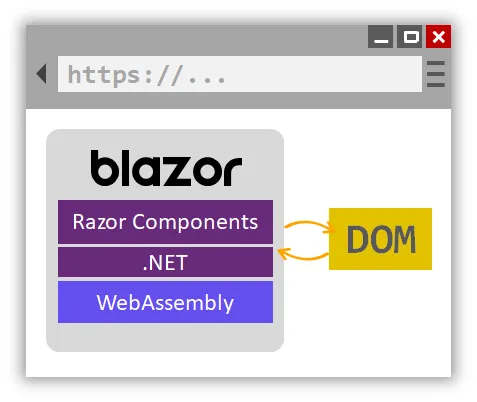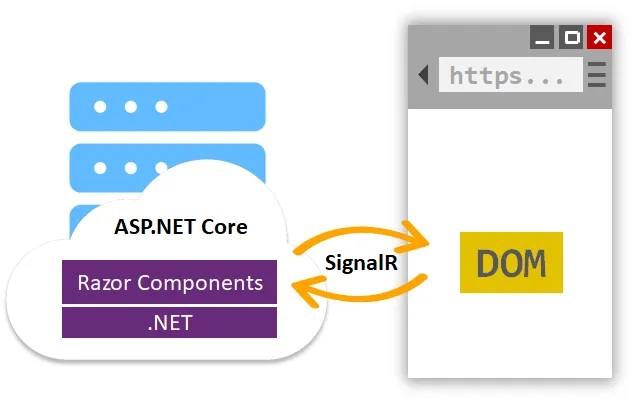Published June 28, 2023
Blazor vs MVC (How It Works For Developers)
In the realm of web development, there are various frameworks and technologies available that developers can choose from to build robust and interactive applications. Blazor and MVC (Model-View-Controller) in the .Net core are two highly regarded options that have gained significant traction in recent years. Both frameworks offer distinct advantages and cater to different development scenarios. In this article, we will delve into the intricacies of Blazor and MVC, comparing their features, architecture, use cases, performance, development workflow, and more, enabling developers to make an informed decision.
What are Blazor and MVC in ASP.NET Core?
MVC
MVC, or Model-View-Controller, is a software architectural pattern that separates the application logic into three interconnected components: Model, View, and Controller. This pattern has been widely adopted in web development due to its clear separation of concerns and ease of maintenance. With MVC, the Model represents the data and business logic, the View defines the user interface and the Controller handles user input and updates the Model and View accordingly.
Blazor
Blazor, developed by Microsoft, is a free and open-source web framework that enables developers to build interactive web applications using C# instead of relying heavily on JavaScript. Blazor leverages WebAssembly, a binary instruction format that enables running code written in different languages in web browsers.
Blazor offers two hosting models: Blazor WebAssembly and Blazor Server. In the WebAssembly model, the entire application is executed client-side in the browser, while in the Server model, the application logic runs on the server, and the UI is rendered and updated in the browser using SignalR.
Working of Blazor and ASP.NET MVC
Working of MVC
MVC follows a clear separation of concerns, dividing the application logic into three interconnected components: Model, View, and Controller.
Model: The Model represents the data and business logic of the application. It encapsulates the data structures and defines the rules and operations for manipulating the data. It interacts with the database or external data sources to fetch or update data. The Model component is responsible for maintaining data integrity, performing validations, and executing business logic.
View: The View is responsible for presenting the data to the user and capturing user input. It displays the information retrieved from the Model in a user-friendly format. The View can be a web page, a user interface screen, or any other means of visual representation. It does not contain any business logic but rather focuses on the display and presentation of data.
Controller: The Controller acts as an intermediary between the Model and the View. It receives user input from the View, processes it, and determines the appropriate actions to be taken. The Controller interacts with the Model to retrieve or update data and then updates the View with the modified data. It handles user actions, such as button clicks or form submissions, and initiates the necessary operations in the Model.
The working of MVC involves the following steps:
- The user interacts with the View, such as submitting a form or clicking a button. The View captures the user input and sends it to the Controller for processing.
- The Controller receives the user input from the View. It analyzes the input, performs the required operations on the Model, and updates the data accordingly. The Controller can query the Model for data or modify the data based on the user input.
- Once the Controller has processed the user input, it updates the Model with the new data or modifies the existing data. The Model ensures data integrity, performs business logic operations, and applies any necessary validations.
- After the Model is updated, the Controller sends the updated data to the View for presentation. The View receives the data from the Controller and renders it in the appropriate format for the user. The updated View is then displayed to the user, reflecting any changes made in the Model.
- The updated View is presented to the user, who can then interact with the application again. This completes one cycle of the MVC pattern. The user can continue interacting with the View, triggering subsequent actions in the Controller and updates in the Model.

The request-response cycle in MVC ensures that user input triggers appropriate actions, data is processed and updated, and the updated data is presented back to the user. This separation of concerns facilitates code modularity, testability, and maintainability.
Working of Blazor
Blazor is a web framework that enables developers to build interactive web apps using C# instead of relying heavily on JavaScript. It utilizes WebAssembly and offers two hosting models Blazor WebAssembly and Blazor Server.
Blazor WebAssembly
Blazor WebAssembly allows the entire application to run client-side in the user's browser. Here's how it works:
- When a user accesses a Blazor WebAssembly application, the required files, including the compiled C# code, HTML, CSS, and JavaScript, are downloaded to the user's browser.
- The downloaded Blazor WebAssembly files are executed by the WebAssembly runtime in the browser environment. WebAssembly is a binary instruction format that enables running code written in various languages, including C#, directly in the browser.
- Blazor WebAssembly uses components as the fundamental building blocks of the user interface. Components are written in C# and employ a syntax similar to HTML called Razor syntax. When the Blazor WebAssembly application runs, the browser renders the initial component defined in the application's entry point.
- User interactions, such as button clicks or form submissions, trigger events within the Blazor WebAssembly application. These events are handled by the C# code defined within the components. The event handlers can perform various operations, such as updating the application state, making web API calls, or modifying the UI.
- Blazor WebAssembly components have a lifecycle that includes different stages, such as initialization, rendering, and disposal. During this lifecycle, components can handle events, modify the application state, and trigger UI updates. Blazor provides lifecycle methods that developers can override to execute specific actions at various stages of the component's lifecycle.
- Blazor WebAssembly applications can communicate with APIs, services, and databases using C#. Developers can make HTTP requests, invoke RESTful APIs, or utilize gRPC for communication. Blazor WebAssembly provides libraries and tools, such as HttpClient, to simplify API interactions.

Blazor Server
In Blazor Server, the application logic runs on the server, and the UI is rendered and updated on the client side using SignalR. Here's a breakdown of how it functions:
- When a user accesses a Blazor Server application, the initial HTML page is loaded, similar to traditional web applications. The page references the JavaScript and SignalR client-side libraries required for communication with the server.
- In Blazor Server, user interactions, such as button clicks, are sent to the server via SignalR, a real-time web communication library. The server-side code processes these events and updates the application state accordingly.
- After processing the user event, the server generates updated UI components based on the changes in the application state. These updated components are sent back to the client side using SignalR connection.
- On the client side, the JavaScript code receives the updated UI Razor components from the server. It applies these updates to the Document Object Model (DOM), ensuring that the UI reflects the changes made on the server side. This approach allows for a responsive user experience since only UI changes are transmitted over the network, minimizing data transfer.
- Blazor Server leverages SignalR to provide real-time updates. When the application state changes on the server side, the server pushes the updated UI components to the client side, ensuring that the UI remains synchronized with the server's state. This real-time communication enables interactive and collaborative experiences in Blazor Server applications.

Both Blazor WebAssembly and Blazor Server empower developers to write C# code for both the client-side and server-side logic. They provide features like component rendering, data binding, and communication with APIs, allowing for the development of rich, interactive web applications using the power of C#
Pros and Cons of Blazor and MVC
Let's delve into a detailed exploration of the pros and cons of Blazor and MVC. Understanding the strengths and weaknesses of these frameworks will help you make an informed decision about which one is the best fit for your web development projects. So, let's weigh the advantages and considerations of Blazor and MVC to guide you in choosing the right approach for your specific requirements.
Blazor Pros
- Single language development with C#: Blazor app allows software developers to use C# for both client-side and server-side logic, promoting code sharing and reusability.
- Rich and interactive user interfaces: Blazor apps enable the creation of dynamic and engaging UIs using C# and Razor syntax.
- Full .NET ecosystem integration: Developers can leverage the extensive collection of .NET code libraries, frameworks, and tools for enhanced productivity.
- Improved performance (Blazor WebAssembly): Blazor WebAssembly applications run directly in the browser, resulting in faster loading times and reduced server requests.
- Cross-platform development capabilities: Blazor WebAssembly supports deployment on various platforms, expanding the reach of the applications.
MVC Pros
- Well-established pattern: MVC provides a proven architectural pattern for structuring applications, facilitating code maintenance and testing.
- Flexibility and customization: MVC offers fine-grained control over the application's behavior and appearance, allowing for highly customized web applications.
- Strong community support: MVC has a large and active community, providing ample resources, documentation, and community-driven support.
- SEO-friendly URLs: MVC applications generate clean and search engine-friendly URLs, aiding in search engine optimization efforts.
- Legacy integration: MVC is well-suited for integrating with existing legacy systems or databases, providing flexibility in working with different data sources.
Blazor Cons
- Learning curve: As a relatively new framework, Blazor may require developers to invest time in learning its concepts, syntax, and best practices.
- Limited browser support (Blazor WebAssembly): Older browsers without WebAssembly support may not be able to run Blazor WebAssembly applications, impacting audience reach.
- Larger file sizes and longer load times (Blazor WebAssembly): Blazor WebAssembly applications require downloading runtime and application files, resulting in larger sizes and longer initial load times.
MVC Cons
- Increased complexity with larger applications: MVC applications can become complex as they grow in size and complexity, requiring careful management of dependencies.
- Longer development time: The customization and fine-grained control of MVC can lead to longer development cycles compared to simpler frameworks.
- Limited real-time updates: Achieving real-time updates and dynamic UI changes may require additional complexity and the use of libraries like SignalR in MVC.
Considering these factors, developers should carefully evaluate the requirements and trade-offs to choose between Blazor and MVC for their specific project needs.
Comparison MVC vs Blazor
MVC (Model-View-Controller) and Blazor are two distinct web development frameworks that offer different approaches and advantages. Let's compare MVC and Blazor based on various factors:
Architecture
MVC: MVC follows a well-established architectural pattern, separating the application logic into three components: Model, View, and Controller. It promotes the separation of concerns and provides a structured approach to development.
Blazor: Blazor introduces a component-based architecture, where UI components are created using C# and Razor syntax. It combines the benefits of both client-side and server-side development approaches.
Language and Tooling
MVC: MVC primarily uses C# for server-side logic and HTML, CSS, and JavaScript for the front end. It has extensive tooling and a mature ecosystem for building web applications.
Blazor: Blazor allows developers to write both client-side and server-side logic using C#. It provides a unified programming model for front-end and back-end development, reducing the need to switch between different languages.
Performance
MVC: MVC applications typically rely on server-side rendering, where the server generates the HTML and sends it to the client. This approach may result in slower initial loading times and increased server requests for dynamic content.
Blazor: Blazor offers two modes - Blazor WebAssembly and Blazor Server. Blazor WebAssembly runs client-side in the browser, enabling faster loading times and reducing server requests. Blazor Server relies on real-time communication with the server, providing a responsive user experience.
Development Productivity
MVC: MVC provides a mature development pattern, extensive tooling, and a large community. Developers can leverage existing libraries and frameworks, speeding up development and troubleshooting.
Blazor: Blazor's component-based architecture promotes code reusability and modularity, making it easier to build complex UI elements. The integration with the .NET ecosystem allows developers to leverage existing libraries and tools.
Browser Support
MVC: MVC applications have wide browser compatibility since they rely on standard HTML, CSS, and JavaScript.
Blazor: Blazor WebAssembly requires modern browser support for WebAssembly. Older browsers may not be compatible, limiting the audience reach for Blazor WebAssembly applications.
Ultimately, the choice between MVC and Blazor depends on factors such as project requirements, team expertise, and performance considerations. MVC is a solid choice for traditional server-side rendering and established development practices. Blazor, on the other hand, offers a modern and unified development experience with the power of C# on both the client and server sides.
Conclusion
Blazor and MVC are both powerful frameworks with their own strengths and use cases. MVC offers a proven architecture, excellent performance, and an extensive ecosystem, making it a reliable choice for traditional web development. On the other hand, Blazor empowers developers to build interactive web applications using C#, promoting code sharing and providing a more modern and streamlined development workflow.
The choice between Blazor and MVC ultimately depends on the specific requirements of the project, the developer's familiarity with the technologies, and the desired user experience. Both frameworks have their merits, and developers should carefully consider these factors before making a decision. Regardless of the choice, both Blazor and MVC contribute to the thriving web development landscape, catering to different needs and driving innovation in the industry. With continuous updates and community support, both frameworks are poised to evolve and address the ever-changing demands of web development.
IronPDF offers a user-friendly solution for creating, reading, updating, and manipulating PDF files in both MVC and Blazor applications. As a valuable component of Iron Software's Iron Suite, it includes a suite of five beneficial libraries that assist in the development of MVC or Blazor web apps with features like Excel integration, PDF manipulation, barcode generation, QR code generation, and image handling. The Iron Suite is available free of charge to users for personal use, and if you require a commercial license, you can find more information by clicking here.











